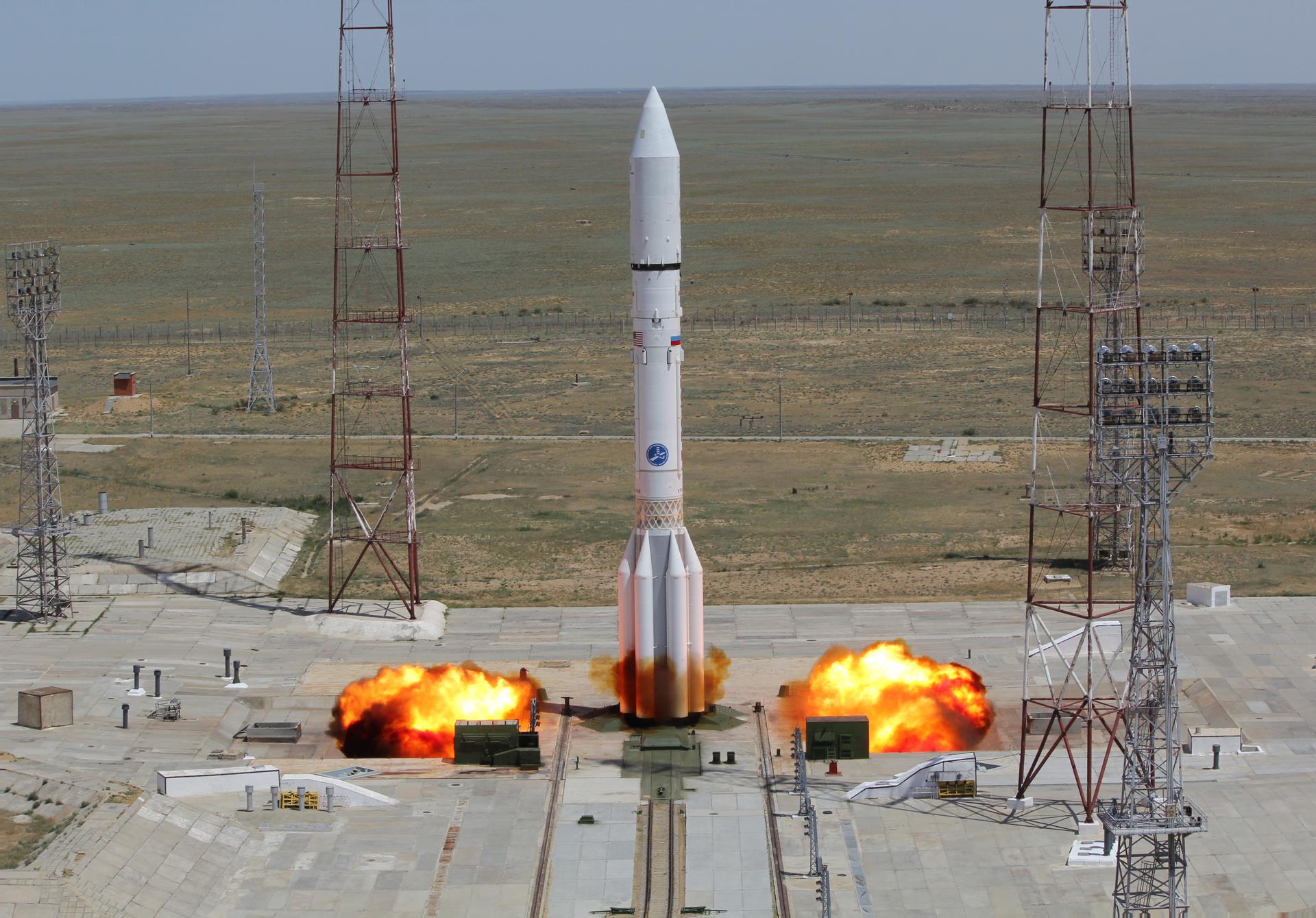
Proton-M
ActiveKhrunichev State Research and Production Space Center (KhSC)
Dec. 5, 2010
Description
Proton-M Blok DM-03 is a four stage Russian heavy lift launch vehicle derived from the Soviet Proton launch vehicle. It is a Proton-M with an added DM-03 Fourth stage.
Specifications
-
Stages
4 -
Length
58.2 m -
Diameter
7.4 m -
Fairing Diameter
4.35 m -
Launch Mass
712.0 T -
Thrust
10532.0 kN
Family
-
Name
Proton-M -
Family
― -
Variant
M Blok DM-03 -
Alias
― -
Full Name
Proton-M Blok DM-03
Payload Capacity
-
Launch Cost
$65000000 -
Low Earth Orbit
2100.0 kg -
Geostationary Transfer
Orbit
6920.0 kg -
Direct Geostationary
3250.0 kg -
Sun-Synchronous Capacity
―
Khrunichev State Research and Production Space Center
Government
Director: Andrey Vladimirovich Kalinovskiy
KhSC 1916Khrunichev State Research and Production Space Center is a Moscow-based producer of spacecraft and space-launch systems, including the Proton and Rokot rockets and is currently developing the Angara rocket family. The Proton launch vehicle launches from Baikonur and Rokot launches from Baikonur and Plesetsk. Angara will launch from Plesetsk and Vostochny.
Upcoming Spaceflights
Proton-M/Blok DM-03 | Elektro-L No.5
Khrunichev State Research and Production Space Center | RussiaBaikonur Cosmodrome, Republic of Kazakhstan
Dec. 15, 2025, 12:20 p.m.
Status: Go for Launch
Mission:
Elektro-L is a series of meteorological satellites developed for the Russian Federal Space Agency by NPO Lavochkin. They are designed to capture real-time images of clouds and the Earth's underlying surface, heliogeophysical measurements, collection and translating hydrometeorological and service data.
Geostationary OrbitProton-M/Blok DM-03 | Elektro-L No.4
Khrunichev State Research and Production Space Center | RussiaBaikonur Cosmodrome, Republic of Kazakhstan
Feb. 5, 2023, 9:12 a.m.
Status: Launch Successful
Mission:
Elektro-L is a series of meteorological satellites developed for the Russian Federal Space Agency by NPO Lavochkin. They are designed to capture real-time images of clouds and the Earth's underlying surface, heliogeophysical measurements, collection and translating hydrometeorological and service data.
Geostationary OrbitProton-M/Blok DM-03 | AngoSat-2
Khrunichev State Research and Production Space Center | RussiaBaikonur Cosmodrome, Republic of Kazakhstan
Oct. 12, 2022, 3 p.m.
Status: Launch Successful
Mission:
The AngoSat 2 is a communications satellite built for Angola to replace the failed AngoSat 1. The Angosat Project calls for development of a communications satellite with C- and Ku-band transponders, its launch into a geostationary orbit and development of the ground communication and TV broadcasting infrastructure. In August 2019 it was revealed the replacement satellite is being built by ISS Reshetnev (Bus) and Airbus Defence & Space (payload). Construction has started in February 2018.
Geostationary OrbitProton-M/Blok DM-03 | Elektro-L No.3
Khrunichev State Research and Production Space Center | RussiaBaikonur Cosmodrome, Republic of Kazakhstan
Dec. 24, 2019, 12:03 p.m.
Status: Launch Successful
Mission:
Elektro-L is a series of meteorological satellites developed for the Russian Federal Space Agency by NPO Lavochkin. They are designed to capture real-time images of clouds and the Earth’s underlying surface, heliogeophysical measurements, collection and translating hydrometeorological and service data.
Geostationary Transfer OrbitProton-M/Blok DM-03 | Spektr-RG
Khrunichev State Research and Production Space Center | RussiaBaikonur Cosmodrome, Republic of Kazakhstan
July 13, 2019, 12:30 p.m.
Proton-M/Blok DM-03 | Ekspress AM8
Khrunichev State Research and Production Space Center | RussiaBaikonur Cosmodrome, Republic of Kazakhstan
Sept. 14, 2015, 7 p.m.
Proton-M/Blok DM-03 | Uragan-M No.48, 49 & 50
Khrunichev State Research and Production Space Center | RussiaBaikonur Cosmodrome, Republic of Kazakhstan
July 2, 2013, 2:38 a.m.
Proton-M Blok-DM-03 | 3 x Glonass-M (Kosmos 2470, Kosmos 2471, Kosmos 2472)
Khrunichev State Research and Production Space Center | RussiaBaikonur Cosmodrome, Republic of Kazakhstan
Dec. 5, 2010, 10:25 a.m.
Status: Launch Failure
Mission:
Glonass-M, also known as Uragan-M, are the second generation of Uragan satellite design used for GLONASS satellite navigation system. GLONASS is a Russian space-based navigation system comparable to the similar GPS and Galileo systems. This generation improves on accuracy, power consumption and design life. Each satellite weighs 1415 kg, is equipped with 12 L-band antennas, and has an operational lifetime of 7 years.
Medium Earth OrbitFalcon 9
Starlink Group 15-11
Space Launch Complex 4E - Vandenberg SFB, CA, USAA batch of 27 satellites for the Starlink mega-constellation - SpaceX's project for space-based Internet communication system.
Kinetica 1
9 satellites
Launch Area 130 - Jiuquan Satellite Launch Center, People's Republic of ChinaShare ride of 9 satellites to sun-synchronous orbit: * Satellite 813 (United Arab Emirates) * Jilin-1 Gaofen 07B-01/07C-01/07D-01 * Dongpo-15 …
Falcon 9
NROL-77
Space Launch Complex 40 - Cape Canaveral SFS, FL, USAClassified payload for the US National Reconnaissance Office.
Long March 3B/E
TJSW-22
Launch Complex 3 (LC-3/LA-1) - Xichang Satellite Launch Center, People's Republic of ChinaChinese classified satellite claimed to be for communication technology test purposes. Actual mission not known.
Long March 4B
Yaogan 47
Launch Area 94 (SLS-2 / 603) - Jiuquan Satellite Launch Center, People's Republic of ChinaThe Yaogan 47 is a Chinese military “remote sensing” satellite of unknown purposes.

